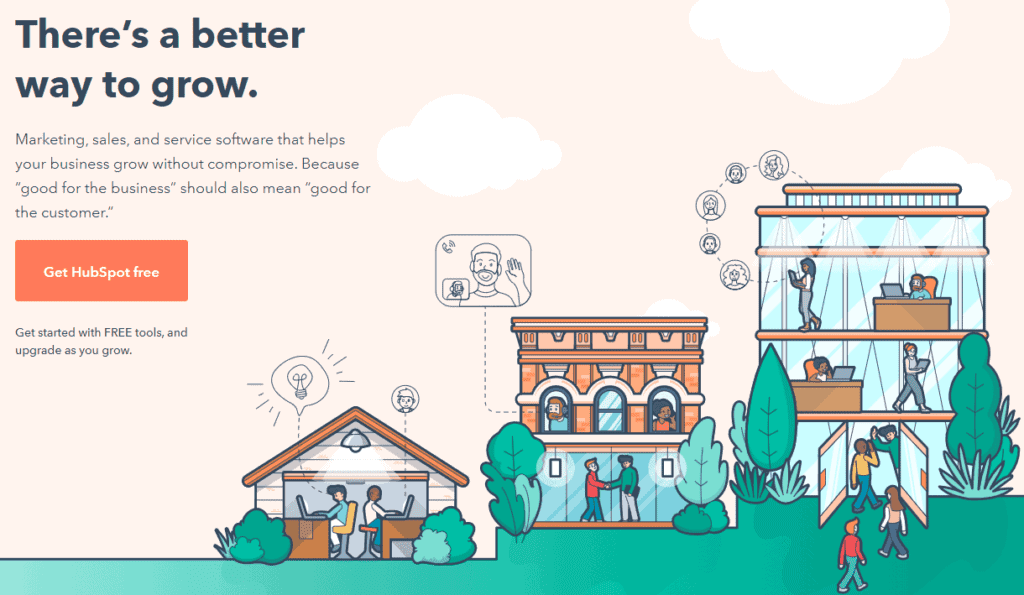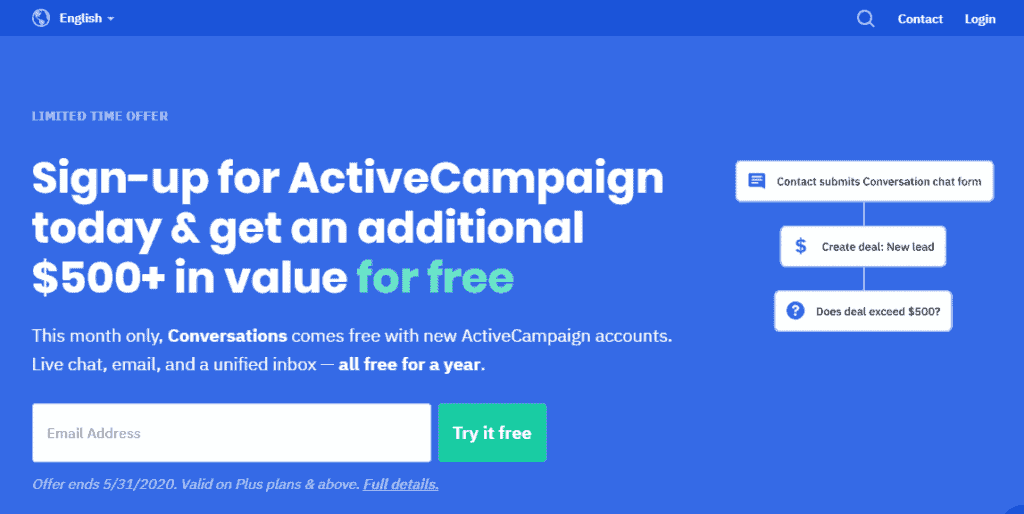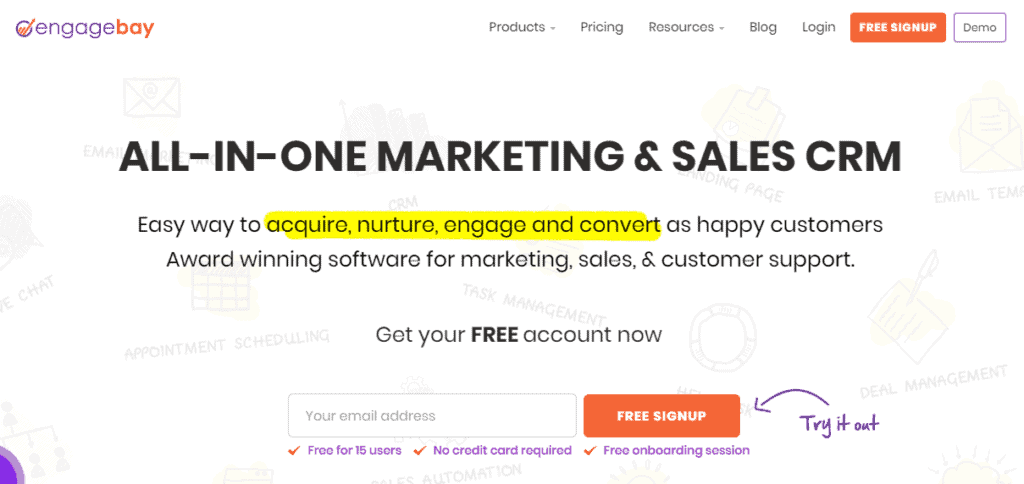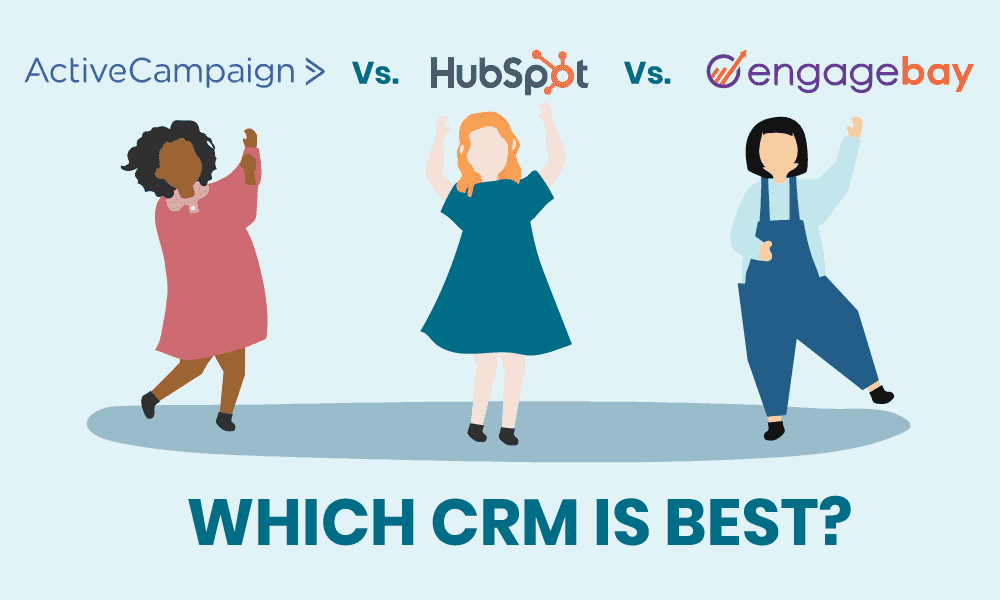If your business is on the hunt for a CRM, then you might opt for HubSpot by name recognition alone. Yet when comparing HubSpot and ActiveCampaign, is one CRM more affordable than another? What about EngageBay’s CRM?
The CRM you choose for your company is a very important decision. That’s doubly true if you’re a small business or startup owner, as you’ll rely on this software to further your business during those critical early days.
HubSpot, while an attractive CRM to many, is far from your only option. ActiveCampaign is a well-ranking CRM, and EngageBay has emerged as a worthy contender and HubSpot alternative.
In today’s post, we’ll tell you how to pick a winner in the great battle of HubSpot vs. ActiveCampaign vs. EngageBay. To do that, we’ll cover the features, pricing, and pros and cons of each respective company’s CRM software.
Table of Contents
By the time you’re done reading, you should feel confidently able to decide which company’s CRM will best support your small business needs.
HubSpot CRM – Features, Pricing, and Pros and Cons

HubSpot is one of those companies that needs no introduction, but we’ll do it anyway. Founded in 2006, HubSpot has since topped other marketing and sales software to sit firmly on top.
The company’s software solutions include a CMS Hub, Service Hub, Sales Hub, Marketing Hub, and its CRM.
Features
- Reporting dashboard to oversee relationship management, track leads, review tasks in-progress, and more
- Email marketing, including personalization
- Deals, including active and closed deals
- Forms for lead generation that don’t require coding knowledge
- Customer support tickets so the appropriate members of your team can see and address the tickets
- Prospect tracking for identifying and understanding a prospect’s online behavior
- Pipeline management for a clear-cut view of your sales pipeline from beginning to end
- Integrations with other software, including more than 300 options and counting
- Productivity tools to keep the whole company motivated to get more done
- Reports, including time-to-close reports and tickets-closed reports to aide customer service reps
- Preset email templates that save time in sending and responding to emails
- Conversation inbox that records interactions with your customers, including across multiple members of your team
- Chatbots and live chat so your customers can get their questions answered quickly
- Ad management for tracking the success of your advertisements in progress
- Landing page builder for creating professional-looking landing pages
- Chatbot builder for customizing the chatbot to your small business’ needs
- Email notifications and tracking so you know when customers opened your emails and which ones
- Meeting scheduling so curious prospects and customers can sit down and talk with your sales team when they’re ready
Pricing
HubSpot pricing for their CRM is always free. This may appear pretty great on the surface, but things are not as they seem.
You see, to make the most of HubSpot’s features as included in the CRM, you need to pay for their services.
You get only limited forms with the free plan, 2,000 emails a month, $1,000 to spend on ads, five list segmentation options, one conversation inbox, and limited chatbot features.
Sure, for brand-new small businesses and startups, these limited features might suffice. As you grow and need more though, you’re forced into paying for at least the Starter plan, which is $50 per month per user.
Maybe that’s not bad, but having to jump a tier to the Professional plan will set you back $800 per month per user. You better have a sizable sales, marketing, and CRM budget at that point!
Pros and Cons
One of the biggest upsides to using HubSpot is their name recognition. Since they’re trusted by so many salespeople and marketers, you know you’d make a solid decision when you use their services.
The wealth of integrations HubSpot offers is also to its benefit. Further, that its CRM is always free is enough to entice even small businesses and startups to try HubSpot’s services.
As I said though, you’re quite limited with what you can do in your HubSpot CRM unless you buy the Starter plan. Even then, if you want to make more comprehensive landing pages, use more than 10 reporting dashboards or more than one conversation inbox, or make more than 25 segmented lists, you have to pay for the Professional plan.
The cost of the Professional plan–$800 a month–is too far out of reach for most businesses. If you had five people using HubSpot’s Professional CRM, that’s $4,000 per month you’d have to pay!
Forget it.
ActiveCampaign CRM – Features, Pricing, and Pros and Cons

Founded in 2003, ActiveCampaign actually predates HubSpot by three years. Their products include sales automation, marketing automation, email marketing, CRM, and more.
Now that you’re well-acquainted with HubSpot’s CRM, next, I want to discuss the CRM offered by ActiveCampaign.
Features
Labeled as a sales CRM, ActiveCampaign’s solution should also suit marketers, business owners, and customer service reps. Here’s an overview of those features:
- Email notifications so your sales team gets notifications on following up in their nurture campaigns and sales automations
- Lead scoring for tracking sales-qualified and marketing-qualified leads
- Lead segmentation that’s automated depending on lead behavior so you get more scored and sorted leads
- Deal notes so you can write down the contact info and share other pertinent data about a lead or customer with others on your team
- Assigning tasks automatically or manually to relevant team members
- Deal updates, which are also automated, and display info like the value of the deal, how many deals your sales team lost, how many they won, and at which stage the deal is at
- Marketing automation for the sales funnel to continue campaigns to their completion
- Win probability predictions so your sales team knows which leads are worth pursuing and can go after them
- Sales reporting, which includes single sales reps as well as the collective efforts of the whole sales team
- Integrations with more than 280 tools and apps like Calendly, Unbounce, Facebook, and Zendesk
- iOS app for calling, task management, updating lead contact information, and progressing deals even when your sales team isn’t at the office
Pricing
Unlike HubSpot, ActiveCampaign’s CRM is not free. Here’s a glimpse into ActiveCampaign pricing.
- For 500 contacts, the Lite plan is $15 a month, the Plus plan is $70 a month, the Professional plan is $159 a month, and the Enterprise plan is $279 a month
- For 1,000 contacts, the Lite plan is $29 a month, the Plus plan is $70 a month, the Professional plan is $159 a month, and the Enterprise plan is $279 a month
- For 2,500 contacts, the Lite plan is $49 a month, the Plus plan is $125 a month, the Professional plan is $159 a month, and the Enterprise plan is $279 a month
- For 5,000 contacts, the Lite plan is $89 a month, the Plus plan is $169 a month, the Professional plan is $239 a month, and the Enterprise plan is $449 a month
- For 10,000 contacts, the Lite plan is $139 a month, the Plus plan is $249 a month, the Professional plan is $349 a month, and the Enterprise plan is $499 a month
The Lite and Plus plans are pretty affordable until your small business gets to around 5,000 contacts, but that’s a moot point. You don’t even get CRM access until you pay for the Professional plan, and that’s regardless of how many contacts you have.
By that point, you’re spending $159 a month on a CRM, and at most $349 a month. At least you get 50 users for the Professional plan so your money is better allocated.
Are you curious about the alternatives to ActiveCampaign? Our article on the best ActiveCampaign alternatives is a must-read.
Pros and Cons
HubSpot and ActiveCampaign have some obvious differences between them.
The biggest is how HubSpot’s CRM is free, but remember that’s at least on the surface. Ultimately, you’d pay less money to add more users with ActiveCampaign’s CRM. Plus, they’re upfront about their pricing, not masquerading it as free.
ActiveCampaign, although it doesn’t have as many integrations as HubSpot, still offers a lot of the same features in their CRM, plus others it appears HubSpot doesn’t have. For instance, you can get win probability predictions when you pay for ActiveCampaign’s CRM.
Despite that it has services for marketers and customer service reps, ActiveCampaign’s CRM is largely catered towards salespeople. Thus, your company might find it somewhat limiting, which is certainly its biggest downside.
👉Not happy with HubSpot? Take a look at our blog post introducing the top HubSpot competitors.🏅
EngageBay CRM – Features, Pricing, and Pros and Cons

The third CRM that might be the ideal solution for your company is EngageBay. A newer company, EngageBay was founded in 2017 as an all-in-one sales and marketing solution for small businesses and startups on a tight budget.
As a viable HubSpot alternative, EngageBay has a variety of products in its Service Bay, CRM & Sales Bay, Marketing Bay, and the All-in-One Suite.
Features
According to EngageBay, their CRM is tailored for small businesses and startups, a consideration that both ActiveCampaign and HubSpot definitely appear to have ignored.
Here’s what you’ll find in EngageBay’s CRM:
- Contact management and organization for targeting your campaigns and personalizing your communications with your leads and customers
- Pipeline visualization for seeing which deals are in progress, which are nearly closed, and which deals are closed
- Appointment scheduling with the sales team via their individual or team calendar so leads can get in touch with the right parties they want to talk with
- Contact management, including a rich and detailed history of every past interaction with a lead or customer
- Integrated tools for both sales and marketers to use so they can sync and send crucial information to one another
- Task creation and assignments so your sales and marketing teams can follow up with a lead when necessary to increase your chances of conversions
- Automated data entry so your sales team and marketers waste less time on data logging
- Comprehensive sales reporting on an individual and team level to inspire future successes and discover areas to be learned from
- Gamification and leaderboards to motivate your sales team to perform at their best every time
- Syncing between CRM and email with CRM Email Integration, a two-way email system that makes a copy of the email within the CRM for your company’s records
- Lead scoring for finding qualified leads who are more likely to become customers
- Call integration via CRM Telephony to log call records and provide transcripts that can come in handy for other members of your sales and marketing team who may interact with that same lead or customer later
Pricing
If EngageBay’s CRM seems more suitable to you as a startup or small business owner, you’re undoubtedly going to worry about pricing.
Worry you won’t have to, as EngageBay’s sales and marketing CRM is always free. This isn’t conditional like HubSpot, where you get hardly any features until you pay an arm and a leg.
EngageBay has a free plan that lets you send 1,000 branded emails and add 1,000 contacts. You also can use live chat, a helpdesk, a landing page builder, lead grabbers, and sequences. Further, you can broadcast emails and take advantage of EngageBay’s inclusive email marketing features.
The Basic plan costs only $14.99 per user per month if you want to take things one step up. Now you can send 10,000 emails–all branded–and add 15,000 contacts.
Further, you’ll gain access to the tag manager, social suite, SMS marketing, lead scoring, web pop-ups, and email templates.
Pros and Cons
EngageBay arose out of a need to provide a more affordable alternative to HubSpot’s services. That’s why their CRM is always free, no strings attached.
As you’re surely aware by now, you don’t get that same guarantee with HubSpot, far from it.
Although you’re not paying for EngageBay’s CRM, you don’t have to skimp on features, not in the least. You’ll find many of the same features as what you’re paying upwards of $100 a month to use as part of HubSpot or ActiveCampaign’s respective CRM options as well as unique features only available through EngageBay.
If your small business grows, EngageBay keeps its pricing plans affordable. Even the Growth plan with 50,000 contacts and 25,000 branded emails costs $49.99 per month per user and the Pro plan with unlimited contacts and 50,000 branded emails is $79.99 per month per user.
Read also: HubSpot vs GetResponse: A Comprehensive Review and Analysis
Which CRM Is Right for You: ActiveCampaign, HubSpot, or EngageBay?
The debate between ActiveCampaign, HubSpot, or EngageBay regarding which CRM is the best for your business doesn’t have to be a major head-scratcher.
HubSpot has a free CRM to lure you in, but it’s inefficient on its own, making you pay for one of their expensive monthly plans. That would knock HubSpot out of contention, we’d say.
ActiveCampaign doesn’t try to pretend its CRM is free, but they’re not exactly scalable either. As your company expands, ActiveCampaign’s prices go steeply up, which doesn’t make them a very suitable option for a growing small business.
That leaves EngageBay. When EngageBay says its CRM is free, they mean it, with no underhanded tactics to try to lure you into spending more money.
You also have enough free features that your small business won’t feel like it’s lacking anywhere. With EngageBay’s CRM, you can get a comfortable start promoting your business through marketing and growing it with sales.
The scalability of EngageBay is also pretty fantastic. You can jump to 15,000 contacts and 10,000 branded emails by spending only $14.99 a month per user, keeping your CRM prices manageable.
If your company ever needs to log 50,000 contacts, that comes at a price jump of about $30 to $49.99 a month per user. Remember, HubSpot’s Starter plan is $50 a month, then their Professional plan costs $800. That’s a $750 jump, which is astronomically high!
EngageBay gives you more CRM features at a better value pound for pound. By paying more elsewhere, you’re only doing your small business or startup a disservice.
Conclusion
Pondering over which CRM is right for your small business or startup doesn’t have to leave you in agony any longer. As promised, we had a winner emerge between HubSpot, ActiveCampaign, and EngageBay.
The winner is, hands down, EngageBay, especially if you care about saving money and scalability.
If you were wondering if your small business should choose ActiveCampaign or HubSpot for your CRM or if EngageBay is your safest bet, hopefully you’re now able to answer that question.
